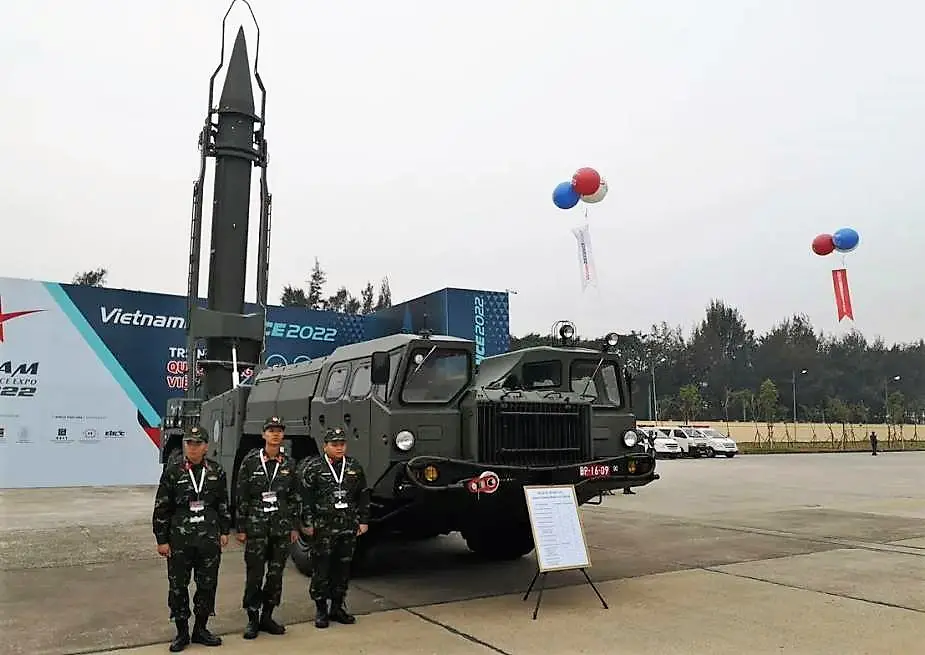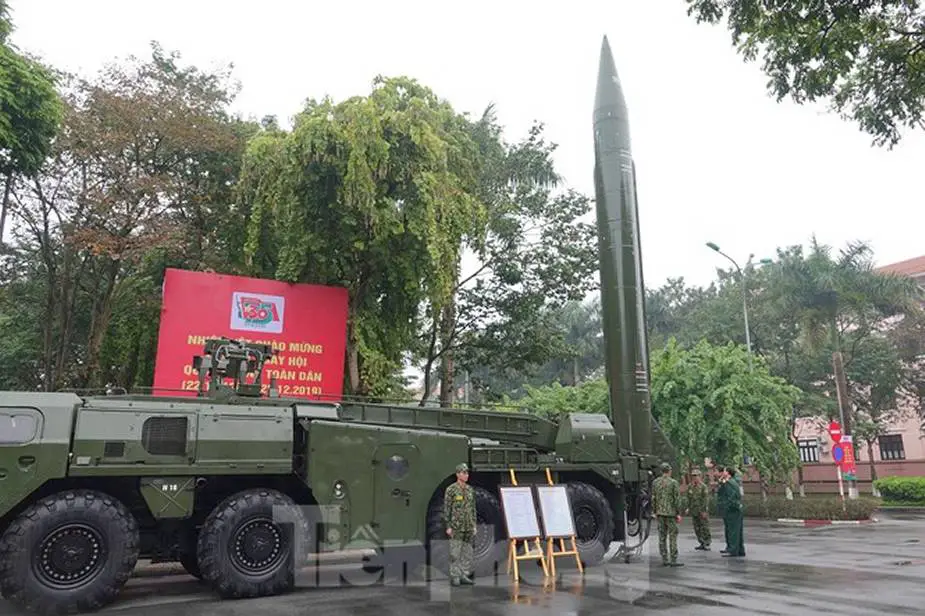Breaking news
Vietnam keeps Soviet-era Scud-B ballistic missiles operational.
As reported on 21stcenturyasianarmsrace.com, in December 2022 a defense exhibition in Hanoi, Vietnam, that was organized by the government included an outdoor exhibition of weapon systems. Coverage from an unlikely source – RosoboronExport, Russia’s arms export agency – revealed the extent of Soviet vintage weaponry still being used. Photos of Vietnam’s R-17E Elbrus, also known as Scud- B, were shared online. Vietnam was always acknowledged to have a stockpile of these liquid-fueled SRBMs but the origin and size were never well-documented.
Follow Army Recognition on Google News at this link

Scud-B of the Vietnamese army displayed in Hanoi in December 2022 (Picture source: RosoboronExport)
Vietnam was reported to have acquired a batch of Soviet-made R-17’s along with their MAZ-series transporters in the 1980s, 21stcenturyasianarmsrace.com recalls, and rumor had it the stockpile was increased with further deliveries from North Korea in the 1990s. The latter was suspected to be the Hwasong-6, a derivative of the R-17.
The 1980s were a challenging period as Vietnam faced international isolation while burdened with occupying Cambodia, where the army had ousted the genocidal Khmer Rouge, and constant battles with China in land and sea. Perhaps the rationale for building up an inventory of short-range ballistic missiles at the time was to deter a perceived invasion threat by a neighboring state.
Vietnam never launched its Scud Bs. At least, there are no records proving otherwise. It’s a testament to the Vietnamese Army’s administrative and logistical talents that these antiquated SRBMs have remained operational until today; more than half a century has passed since the R-17’s were deployed by the Soviets and their Warsaw Pact allies. Of course, Vietnam’s military and its industrial partners go to extreme lengths maintaining their equipment, but to have operational Scud B SRBMs at the ready is no small feat, 21stcenturyasianarmsrace.com comments.
Since its technology dates back to World War 2 a lot of analysis regarding the Scud B points to some drawbacks. First, as a missile using a liquid fuel engine complicates its preparation for launch. By comparison, a solid fuel ballistic missile is quicker to deploy, emplace, and launch, then have its launcher concealed. Second, Western analysis of the Scud B always judged its missile to have no pin-point accuracy – it’s claimed it had a circular error of probability (CEP) equal to a 450-500 meter radius. The Scud B is assessed to have a maximum range of less than 300 km.
The improved liquid-fueled missiles descended from the Scud B and Hwasongs are now being assembled in Yemen with the help of Iran. Functioning Scud missiles are found in Armenia while the Afghan Taliban now possess an unusable stockpile that dates back to the bygone communist regime from the early 1990s. In Southeast Asia, Myanmar and Vietnam are the only known operators of Scud-B missiles, and there’s no evidence these two countries have cooperated to maintain their respective arsenals. Myanmar is extremely secretive of its ballistic missile program and never admitted to acquiring Hwasong-series SRBMs from North Korea or even more sophisticated models from China. Vietnam, on the other hand, has become more open about its tactical missile program since the 2010s and, as with the rest of its arsenal, doesn’t scrimp on building a stockpile. It now fields large-diameter rocket artillery supplied by Israel and naval cruise missiles supplied by Russia. There’s also some evidence of a medium-term program for assembling cruise missiles but it’s unknown if this effort is connected to a ballistic missile program, 21stcenturyasianarmsrace.com concludes.

Vietnamese R-17E tactical ballistic missiles (SS-1C Scud-B) were put on display during National Defense Day 2019. All Vietnamese tactical ballistic missiles belong to the Artillery Corps and are operated by the 490th Brigade (Picture source: Viet Defense)
Scud short-range ballistic missile – Technical data
The Scud-B missile was developed by the Soviet Union in the 1950s and was widely exported to various countries, including Iraq, Libya, Syria, and North Korea. It has been used in several conflicts, including the Iran-Iraq War, the Gulf War, and the Syrian Civil War.
• Length: 11.25 meters (36.9 feet)
• Diameter: 0.88 meters (2.9 feet)
• Launch weight: 5,700 kg (12,500 pounds)
• Range: up to 300 km (186 miles)
• Payload: 985 kg (2,172 pounds)
• Propulsion: single-stage liquid fuel engine
• Warhead: various options, including conventional or nuclear
• Accuracy: relatively poor, with a CEP (circular error probable) of about 450-500 meters (1,475-1,640 feet)
• Launch method: the Scud-B is launched from a mobile transporter erector launcher (TEL) vehicle, which can carry and launch one missile at a time.
• Guidance system: the Scud-B uses an inertial guidance system, which uses gyroscopes and accelerometers to measure the missile's position and velocity, allowing it to navigate to its target.
• Fuel type: the Scud-B uses unsymmetrical dimethylhydrazine (UDMH) as the fuel and nitrogen tetroxide (NTO) as the oxidizer. These hypergolic propellants ignite spontaneously on contact with each other, allowing for rapid engine start-up and high reliability.
• Flight profile: the Scud-B follows a ballistic trajectory, meaning it is launched into the atmosphere and then follows a parabolic arc before re-entering the atmosphere and hitting its target. The missile's flight time is typically around 5-7 minutes.
• Variants: There are several variants of the Scud missile family, including the Scud-A, Scud-C, and Scud-D, which have different ranges and payloads. The Scud-B is the most widely known variant and has been produced in large quantities.
• Countermeasures: The Scud-B missile is relatively slow and can be detected by radar, making it vulnerable to interception by air defense systems. However, its relatively short range and inaccurate guidance make it difficult to intercept in practice. Some countries have developed specific anti-ballistic missile systems to counter the Scud threat, such as the Israeli Arrow missile defense system.
Defense News March 2023


























